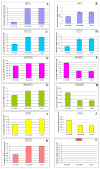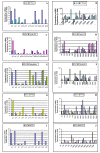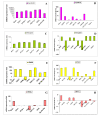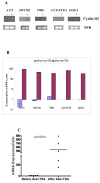Regulation of sonic hedgehog-GLI1 downstream target genes PTCH1, Cyclin D2, Plakoglobin, PAX6 and NKX2.2 and their epigenetic status in medulloblastoma and astrocytoma
- PMID: 21059263
- PMCID: PMC2989332
- DOI: 10.1186/1471-2407-10-614
Regulation of sonic hedgehog-GLI1 downstream target genes PTCH1, Cyclin D2, Plakoglobin, PAX6 and NKX2.2 and their epigenetic status in medulloblastoma and astrocytoma
Abstract
Background: The Sonic hedgehog (Shh) signaling pathway is critical for cell growth and differentiation. Impairment of this pathway can result in both birth defects and cancer. Despite its importance in cancer development, the Shh pathway has not been thoroughly investigated in tumorigenesis of brain tumors. In this study, we sought to understand the regulatory roles of GLI1, the immediate downstream activator of the Shh signaling pathway on its downstream target genes PTCH1, Cyclin D2, Plakoglobin, NKX2.2 and PAX6 in medulloblastoma and astrocytic tumors.
Methods: We silenced GLI1 expression in medulloblastoma and astrocytic cell lines by transfection of siRNA against GLI1. Subsequently, we performed RT-PCR and quantitative real time RT-PCR (qRT-PCR) to assay the expression of downstream target genes PTCH1, Cyclin D2, Plakoglobin, NKX2.2 and PAX6. We also attempted to correlate the pattern of expression of GLI1 and its regulated genes in 14 cell lines and 41 primary medulloblastoma and astrocytoma tumor samples. We also assessed the methylation status of the Cyclin D2 and PTCH1 promoters in these 14 cell lines and 58 primary tumor samples.
Results: Silencing expression of GLI1 resulted up-regulation of all target genes in the medulloblastoma cell line, while only PTCH1 was up-regulated in astrocytoma. We also observed methylation of the cyclin D2 promoter in a significant number of astrocytoma cell lines (63%) and primary astrocytoma tumor samples (32%), but not at all in any medulloblastoma samples. PTCH1 promoter methylation was less frequently observed than Cyclin D2 promoter methylation in astrocytomas, and not at all in medulloblastomas.
Conclusions: Our results demonstrate different regulatory mechanisms of Shh-GLI1 signaling. These differences vary according to the downstream target gene affected, the origin of the tissue, as well as epigenetic regulation of some of these genes.
Figures








Similar articles
-
Expression and epigenetic modulation of sonic hedgehog-GLI1 pathway genes in neuroblastoma cell lines and tumors.Tumour Biol. 2011 Feb;32(1):113-27. doi: 10.1007/s13277-010-0105-x. Epub 2010 Sep 10. Tumour Biol. 2011. PMID: 20830616
-
Differential regulation of Shh-Gli1 cell signalling pathway on homeodomain transcription factors Nkx2.2 and Pax6 during the medulloblastoma genesis.Mol Biol Rep. 2024 Oct 26;51(1):1096. doi: 10.1007/s11033-024-10026-5. Mol Biol Rep. 2024. PMID: 39460795
-
Transcriptional repressor REST drives lineage stage-specific chromatin compaction at Ptch1 and increases AKT activation in a mouse model of medulloblastoma.Sci Signal. 2019 Jan 22;12(565):eaan8680. doi: 10.1126/scisignal.aan8680. Sci Signal. 2019. PMID: 30670636 Free PMC article.
-
The sonic hedgehog-GLI1 signaling pathway in brain tumor development.Expert Opin Ther Targets. 2012 Dec;16(12):1227-38. doi: 10.1517/14728222.2012.720975. Epub 2012 Sep 19. Expert Opin Ther Targets. 2012. PMID: 22992192 Review.
-
Epithelioid Soft Tissue Neoplasm of the Soft Palate with a PTCH1-GLI1 Fusion: A Case Report and Review of the Literature.Head Neck Pathol. 2022 Jun;16(2):621-630. doi: 10.1007/s12105-021-01388-4. Epub 2021 Oct 16. Head Neck Pathol. 2022. PMID: 34655412 Free PMC article. Review.
Cited by
-
Expression of Bmi1, FoxF1, Nanog, and γ-catenin in relation to hedgehog signaling pathway in human non-small-cell lung cancer.Lung. 2013 Oct;191(5):511-21. doi: 10.1007/s00408-013-9490-4. Epub 2013 Jul 18. Lung. 2013. PMID: 23864317
-
Blocking signaling at the level of GLI regulates downstream gene expression and inhibits proliferation of canine osteosarcoma cells.PLoS One. 2014 May 8;9(5):e96593. doi: 10.1371/journal.pone.0096593. eCollection 2014. PLoS One. 2014. PMID: 24810746 Free PMC article.
-
A six-gene-based signature for breast cancer radiotherapy sensitivity estimation.Biosci Rep. 2020 Dec 23;40(12):BSR20202376. doi: 10.1042/BSR20202376. Biosci Rep. 2020. PMID: 33179733 Free PMC article.
-
Medulloblastoma's master regulators and their association with patients' risk.Sci Rep. 2025 May 10;15(1):16310. doi: 10.1038/s41598-025-00763-3. Sci Rep. 2025. PMID: 40348787 Free PMC article.
-
Detection of canonical hedgehog signaling in breast cancer by 131-iodine-labeled derivatives of the sonic hedgehog protein.J Biomed Biotechnol. 2012;2012:639562. doi: 10.1155/2012/639562. Epub 2012 Jun 28. J Biomed Biotechnol. 2012. PMID: 22811598 Free PMC article.
References
-
- Dahmane N, Ruiz i Altaba A. Sonic hedgehog regulates the growth and patterning of the cerebellum. Development. 1999;126:3089–3100. - PubMed
-
- Mo R, Freer AM, Zinyk DL, Crackower MA, Michaud J, Heng HH, Chik KW, Shi XM, Tsui LC, Cheng SH, Joyner AL, Hui C. Specific and redundant functions of Gli2 and Gli3 zinc finger genes in skeletal patterning and development. Development. 1997;124:113–123. - PubMed
Publication types
MeSH terms
Substances
LinkOut - more resources
Full Text Sources
Medical

